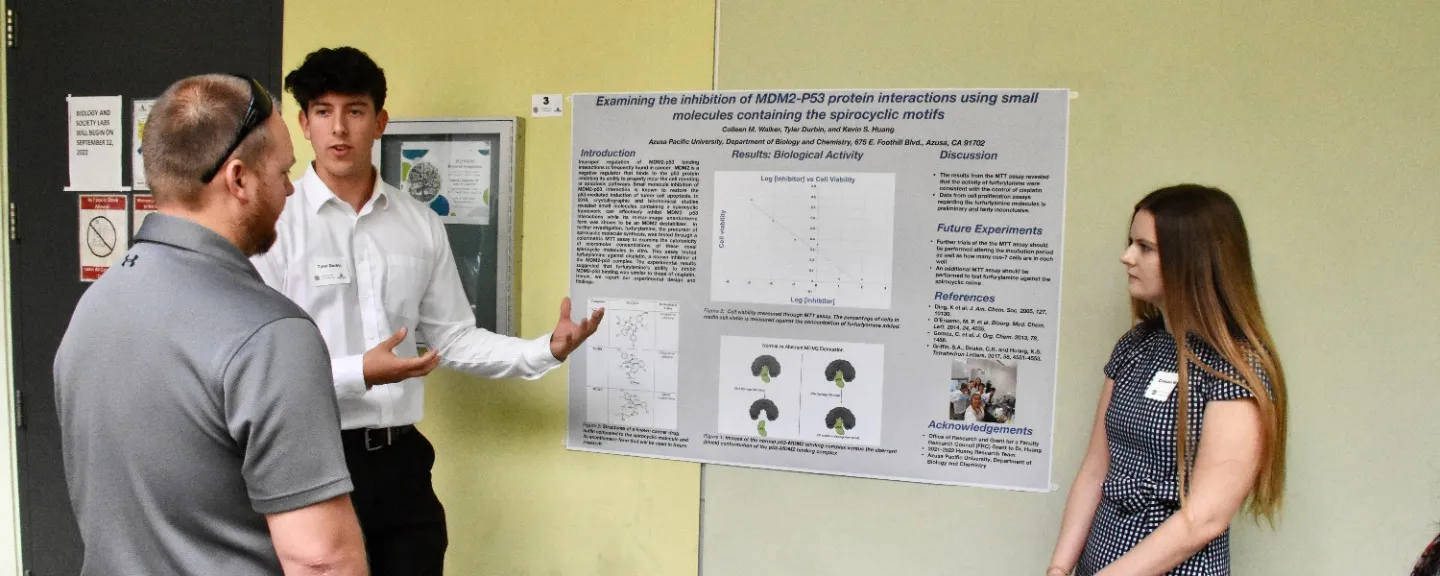- Home
- >
- APU Articles
- >
- News Article
STEM Research Symposium Offers Undergrad Students Unique Opportunity
October 27, 2022 | Written By Nathan Foster

A unique part of this event is the collaboration between departments. While working only a few classrooms away from each other, students rarely get to see what kinds of research other STEM majors are doing. “It was great to see other student’s research,” said William Dortch, a sophomore systems engineering major. “I was amazed at how much work they put into it. It inspired me to go further in my research.” Dortch, alongside sophomore Isaiah Chang, worked with faculty advisor Aisha Chen, PhD, to research music therapy and machine learning. “It’s such a fresh field. We gathered lots of research to assess the best music therapy practices in order to improve movement for patients with neurological disorders such as Alzheimer’s and Parkinson’s.”
Unlike most larger public and private institutions, STEM students at APU have the opportunity to conduct research during their undergraduate years. Dortch said this invaluable experience has taught him a lot. “I definitely learned the importance of time management and having excellent writing skills,” Dortch said. “Doing research at 19 is a lot of responsibility. It’s going to make me better and sharpen me at the end of the day.” Emily Gottry, a senior applied math and honors humanities major, echoed Dortch’s sentiments. “Research was a top priority for me when I was deciding where to go to college,” Gottry said. “I love to see math in action. The opportunity to do that for multiple years during undergrad with an expert to guide me is so impactful.”
Gottry won the “Outstanding Oral Presentation in ECS/MPS” award for her research on multipulsing and bifurcations of optical solitons in the 2D complex cubic-quintic Ginzburg-Landau equation with faculty advisor Edwin Ding, PhD. Since fall 2020, Gottry has worked with Ding to investigate optical solitons, waves that behave like a particle. “They can do some funky things, oscillating or forming two or three pulses instead of just one. The difficulty is that full simulations take a long time,” Gottry said. “We’re building a model to qualitatively reproduce it without taking so long. It’s neat to apply a statistics model on a physical problem.” Gottry said this research experience was paramount in helping her find internships over the past two summers: one at a government research facility and the other doing business analytics for State Farm. She thinks it will also be helpful when she goes to find a job in signals or data analysis.
The symposium prepared students to practice presenting their research, both in written and verbal mediums. Students put together posters showcasing their research, explaining what they had found with other students, faculty, staff, and members of the APU community. For senior organismal biology major Halina Liu, this was her second time presenting at the symposium. “Public speaking was never my strong suit. I was really nervous the first time, but I’ve gotten a lot better and really improved this year,” Liu said. Liu’s research focused on characterizing the kinetics of non-photochemical quenching and efficiency of photoprotection in Helianthus annuus, Venegasia carpesioides, and Celtis reticulata.
Under the direction of faculty advisor Charles Chen, PhD, Liu practiced formulating questions, composing a hypothesis, planning the steps of how to tackle the problem, and finding a solution. Two plants they experimented with were common types of sunflowers, since they’re an important economic crop in the U.S. with their seeds and oil being used frequently in food production. “We investigated how photosynthetic abilities and the photoprotective mechanisms differ in plant species,” Liu said. “By getting familiar with these characteristics, we may one day be able to manipulate these plants in order to increase harvesting, grow food crop yields, and fight food scarcity.” Liu said the research process has taught her a lot about problem solving. “That will be really important going forward after graduation. I’m so glad to have done research in undergrad. It’s a great opportunity at APU and I’d recommend it for anyone who’s interested.”